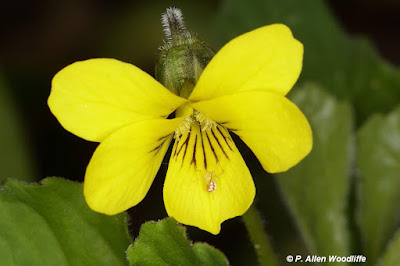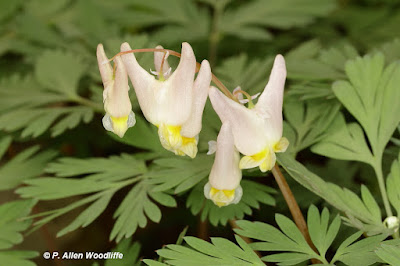The warmer than usual weather of a couple of weeks ago spurred a lot of spring wildflowers on their way. But the cool damp weather of the last few days have slowed their growth, and certainly caused the bird migration to stall, with a few birds dribbling through, but not like most birders hope for in late April and early May.
I know there are some readers who look forward to seeing the variety of spring wildflowers, but for various reasons cannot do it like they used to. As one ages, it is hard to get down to ground level to see them up close, and even harder to get back up again! And then there are some folks who have had a misfortune in their lives that limit their mobility in a serious way. I think of one reader in particular, Furry Gnome, who I have known casually for several decades. He has devoted a significant part of his life and career to protecting and promoting natural areas in various ways. Unfortunately a few years ago as a result of some needed surgery, is now limited to a wheelchair. Yet he continues to try and do the best he can. You can read about his adventures in his blog, which I have listed on the side of my blog site entitled 'Seasons in the Valley.'
This blog post is therefore devoted to those like Furry Gnome, who are unable to see spring wildflowers like they would like to, or used to. I am fortunate that I can still get out and about, and even have a camera body with a tilt screen enabling me to see those flowers up super close, without having to get down on my belly to do so.
What follows does not necessarily represent any particular order of flowering, but to a certain extent, just the way they are labelled. Their order of flowering can vary from site to site, depending on how well they are shaded, what the slope of the ground might be which could favour those getting a stronger sunlight to flower earlier.
Unless otherwise noted, all of the following flowers were photographed in the last couple of weeks.
One of the earliest to flower is this one:
 |
| Bloodroot |
 |
| Cut-leaved Toothwort |
 |
| Downy Yellow Violet |
 | |
| Downy Yellow Violet |
 |
| Early Blue Cohosh |
 |
| Early Buttercup |
 |
| Dutchman's Breeches |
This next one is Squirrel Corn, not nearly as common as Dutchman's Breeches in my experience. The leaves are very similar, so it is necessary to see the actual flowers to determine which species it is.
Yellow Trout Lily, shown next, usually has to have a bright sunny day before the petals open enough to curl back. Sunny days have been few and far between lately so the third one is from a brighter day a year ago.
Very similar to Yellow Trout Lily is White Trout Lily. It isn't as common. Again, it needs a good dose of bright sun to open and the only ones I have seen so far this year are hardly open at all. This one is from a couple of years ago.
Hepatica, shown above, can be one of two different kinds, primarily based on their leaf shape. However early in the season, the flowers typically emerge before the leaves are fully formed, and so are difficult to identify to species. The colours can vary from very white to bluish purple.
Next is Jack-in-the-Pulpit.
Also in the slightly damper parts of a woodland you may come across Purple Cress.
Red Trilliums are always a highlight to see. I am not sure why some have the single petal pointing up, as above, while others have the single petal pointing down.
Red Trilliums always seem to open up a bit earlier than their white counterpart. Most of the White Trilliums I have seen so far are still fairly tightly closed....
...but over the last few days, a few of the whites are showing better.
Spring Beauty, next, is just as its name implies.
One that flowers prolifically, but is seldom noticed, is Wild Ginger. Their distinctive leaves are apparent in various woodlands, but it isn't until you get down and look at the part of the stem right at ground level after brushing away the leaf litter that you can see the chocolatey brown flower resting on the ground. It isn't pollinated by flying insects as most wildflowers are. Instead they are pollinated by invertebrates that crawl on the ground.
A counterpart to the Downy Yellow Violet shown near the beginning is the Downy Blue Violet.
In very wet areas, such as the sloughs of Rondeau, is this Yellow Water Crowfoot, a member of the Buttercup family.
And spring wildflowers are not limited to those fleshy plants growing on the ground. Where there are damp woods, Spicebush, a woody shrub, can be dominant, as it is at Rondeau.
Not a flower in the usual sense, although it is the flowering/spore producing part of a common plant, is this Scarlet Cup, a fungus that is present primarily in spring.
If you would like to subscribe, or unsubscribe, to Nature Nuggets, send an email to: prairietramper@gmail.com

























Thank you so much Allen, both for the compliments and the photos. And you're exactly right, I depend on your blog and a couple of others for my spring walk in the woods. It was always fun trying to get a picture of the Wild Ginger flower.
ReplyDeleteYou are quite welcome, Furry Gnome. I'm so glad to enable you to enjoy the spring woodland wildflowers vicariously!
DeleteThanks Allen, inspiring and informative as always! I’ll be looking for wild ginger now. We went for a walk at John E Pearce on Saturday, where the Dutchman’s Breeches and Red Trilliums were showing beautifully, although the highlight was a Pileated Woodpecker!
ReplyDeleteI'm glad you enjoyed it Christy. Encountering a Pileated is always a highlight!
DeleteOh also, this spring I’ve had an eruption of marsh marigolds all around the water features in the yard that I didn’t empty like usual in the fall. I had to do some research to make sure it wasn’t an invasive copycat but I’m pretty certain it’s the real deal.
ReplyDelete